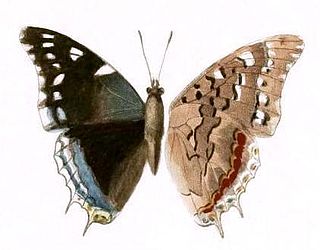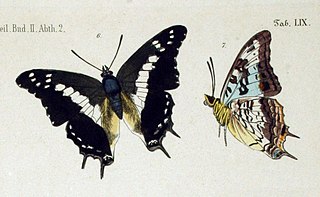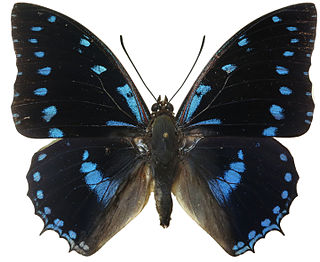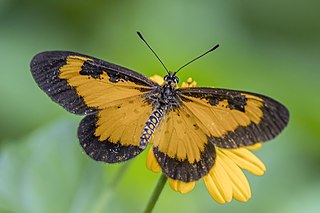
James John Joicey FES was an English amateur entomologist, who assembled an extensive collection of Lepidoptera in his private research museum, called the Hill Museum, in Witley, Surrey. His collection, 40 years in the making, was considered to have been the second largest in the world held privately and to have numbered over 1.5 million specimens. Joicey was a fellow of the Zoological Society of London, the Royal Geographical Society, the Royal Entomological Society, the Royal Horticultural Society, and the Linnean Society of London.

Semioptila is a genus of moths in the family Himantopteridae.

Acraea cerasa, the tree top acraea, is a butterfly of the family Nymphalidae. It is found in most of south-eastern Africa.

Charaxes protoclea, the flame-bordered emperor or flame-bordered charaxes, is a butterfly of the family Nymphalidae. It is found Subsaharan Africa. It is a common forest charaxes.

Charaxes xiphares, the forest king emperor or forest king charaxes, is a butterfly of the family Nymphalidae. It is native to Afromontane forest in the eastern and southern Afrotropical realm.

Charaxes jahlusa, the pearl-spotted emperor or pearl spotted charaxes, is a butterfly of the family Nymphalidae found in southern Africa.

Charaxes guderiana, the blue-spangled emperor, Guderian's charaxes or blue-spangled charaxes, is a butterfly of the family Nymphalidae. It is found in southern Africa.

Charaxes achaemenes, the bushveld emperor or bush charaxes, is a butterfly of the family Nymphalidae found across Africa.

Pseudacraea lucretia, the false diadem or false chief, is a butterfly of the family Nymphalidae. It is found in Africa.

Graphium illyris, the cream-banded swordtail, is a forest butterfly of the swallowtail family (Papilionidae). It is native to the Afrotropical realm.

Charaxes ansorgei is a butterfly in the family Nymphalidae. It is found in Sudan, the Democratic Republic of Congo, Uganda, Rwanda, Burundi, Kenya, Tanzania, Malawi and Zambia. The habitat consists of montane forest on altitudes between 2,000 and 3,000 meters. The larvae feed on Bersama abyssinica abyssinica, Bersama abyssinica englerana and Bersama paullinoides.It was once considered to be a very rare species but it is relatively common in dense and inaccessible montane forests

Charaxes imperialis, the imperial blue charaxes, is a butterfly in the family Nymphalidae. It is found in Guinea-Bissau, Guinea, Sierra Leone, Liberia, Ivory Coast, Ghana, Benin, Nigeria, Cameroon, Equatorial Guinea, the Republic of the Congo, the Central African Republic, the Democratic Republic of the Congo, Rwanda, Uganda, Tanzania and Zambia.

Charaxes ameliae, the blue-spotted charaxes, is a butterfly in the family Nymphalidae. It is found in Guinea, Sierra Leone, Liberia, Ivory Coast, Ghana, Togo, Nigeria, Cameroon, Gabon, the Republic of the Congo, the Central African Republic, the Democratic Republic of the Congo, Uganda, Kenya, Zambia, Tanzania and Malawi.

Charaxes blanda is a butterfly in the family Nymphalidae. It is found in Kenya and Tanzania.

Charaxes etheocles, the demon charaxes, is a butterfly in the family Nymphalidae. It is found in Senegal, Guinea, Sierra Leone, Liberia, Ivory Coast, Ghana, Togo, Nigeria, Cameroon, Gabon, the Central African Republic, the Republic of the Congo, Angola, the Democratic Republic of the Congo, Sudan, Ethiopia, Uganda, Kenya, Tanzania and Zambia.
Bematistes obliqua, the yellow-banded bematistes, is a butterfly in the family Nymphalidae. It is found in Nigeria, Cameroon, the Democratic Republic of the Congo and Uganda.

Acraea acerata, the falls acraea or small yellow-banded acraea, is a butterfly in the family Nymphalidae. It is found in Guinea, Sierra Leone, Liberia, Ivory Coast, Ghana, Togo, Benin, Nigeria, Cameroon, the Republic of the Congo, the Democratic Republic of the Congo, Sudan, Rwanda, Kenya, Tanzania, Zambia, Angola, Mozambique, north-western Zimbabwe, northern Botswana and northern Namibia.
Lasiomorpha is a monotypic moth genus in the family Eupterotidae first described by James John Joicey and George Talbot in 1916. Its single species, Lasiomorpha noakesi, was described by the same authors in the same year. It is found on New Guinea.
Pedoptila nigrocristata is a moth in the Himantopteridae family. It was described by James John Joicey and George Talbot in 1921. It is found in Zambia.
Semioptila latifulva is a moth in the Himantopteridae family. It was described by George Hampson in 1920. It is found in Tanzania.














